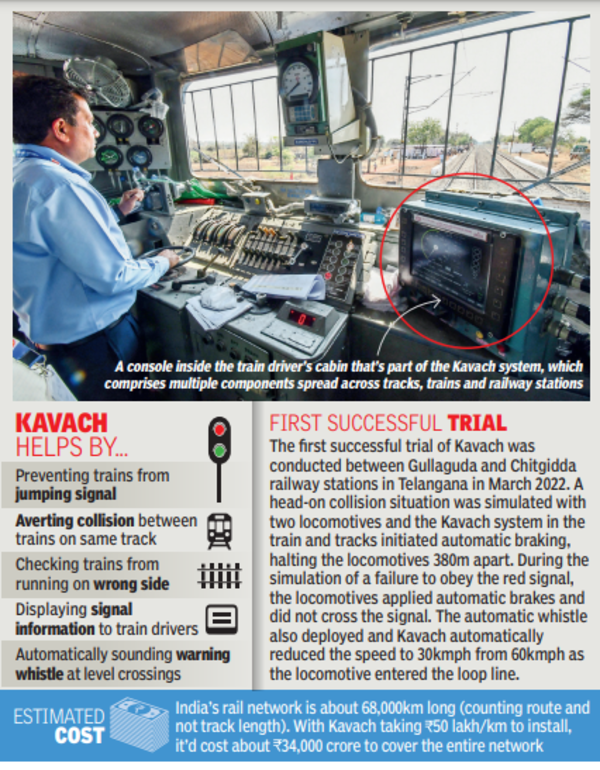On June 17, the Kanchanjungha Express, travelling from Agartala to Sealdah in Kolkata, collided with a goods train at Rangapani, a short distance from New Jalpaiguri. So far, 11 people have died in this crash. Almost exactly a year back, on June 2, the Coromandel Express, travelling from Kolkata to Chennai, collided at full speed with a goods train near Balasore in Odisha, killing 296 people.
Both these
accidents
involved collisions.
Now, we have an indigenously developed technology called
Kavach
to prevent such collisions. While experts say that Kavach may not have been able to prevent the Balasore accident - which also involved a third train - the system should easily have helped avert the Rangapani mishap. The question though is moot since Kavach was absent from the equation in both cases.

So, why is it taking time to roll out Kavach across India's railway network?
Kavach is an electronic system designed and developed by the
Railways
' Research Design and Standards Organisation (RDSO) to achieve zero accidents on tracks by shielding trains against a variety of potential hazards like speeding, failure to obey signal, etc. The system provides continuous updates of 'movement authority', which is the distance up to which a train is permitted to travel without danger. Significantly, in situations where braking is necessary and the train driver has either failed to do so, or is not in a position to do so, the brakes apply automatically.
Since it's aimed at eliminating accidents, the mechanism has undergone rigorous testing and has achieved the highest
safety
levels. It is a Safety Integrity Level 4 (SIL-4) certified technology with the probability of error being one in 10,000 years. Kavach is also the world's cheapest automatic train
collision
protection system, costing Rs 50 lakh/km to operate. Worldwide the cost is around Rs 2 crore/km.
The system uses ultra-high radio frequencies to interconnect its various components. When a train driver jumps a signal - the main reason for train accidents - Kavach sends out a warning. When the system detects another train on the same track within a set distance, it instantly warns the loco pilot, and takes control of the brakes. It applies automatic brakes to prevent speeding and also enables automatic whistling while approaching level-crossing gates.
Deployment
of Kavach involves installation of towers, laying of optical fibre cables along the entire track length and fitting radio frequency, or RFID, tags to tracks. Further, 'loco Kavach' has to be installed in each locomotive and a 'station Kavach' at each station. RFID tags have to be fitted in the sleepers on the tracks in the station section, point zones and near signals and in the block section. Apart from acting as location references, these provide immediate information regarding signals to the train driver.
According to officials, deployment of the system is complex, especially since it has to be installed on existing networks without disrupting train movement.
Till date, Kavach has been deployed on 1,465km of rail route and in 144 locomotives of the South Central Railway. Work to install Kavach on the high-density Delhi-Mumbai and Delhi-Howrah routes (approximately 3,000 route km) is on. Till June 17, optical fibre cables had been laid on 4,055km with 356 telecom towers and other equipment installed at 273 stations and in 301 locomotives.
Indian Railways has so far awarded bids for deployment of Kavach on 6,000km of its network with plans to roll out tenders for 10,000km in the near future.
At present, only three Indian manufacturers - HBL PowerSystems, Kernex, and Medha - are making and deploying the system. Govt is focussing on more players to enhance capacity and scale up implementation.

 1 week ago
18
1 week ago
18








 English (US) ·
English (US) ·